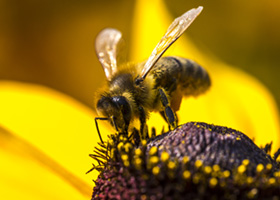Pest Control and Exterminating services in Brooklyn, and all 5 boroughs
 Don’t let a fear of being stung have you running for the indoors. At Abolish Pest Control, our bee exterminator in Brooklyn, NY, is available to tackle your bug problems. No matter how large the infestation is, you can count on our bee and wasp exterminator to deliver an effective solution. We conduct a visual inspection to detect any areas where mechanical control can be applied to get rid of the infestation. Turn to our trained technicians today to eliminate the immediate population in a fast and effective manner.
Don’t let a fear of being stung have you running for the indoors. At Abolish Pest Control, our bee exterminator in Brooklyn, NY, is available to tackle your bug problems. No matter how large the infestation is, you can count on our bee and wasp exterminator to deliver an effective solution. We conduct a visual inspection to detect any areas where mechanical control can be applied to get rid of the infestation. Turn to our trained technicians today to eliminate the immediate population in a fast and effective manner.
Our Wasp Exterminator Works Quickly
A bee or wasp nest at your home or business can be unsettling to see and comes with the threat of a painful sting. When you notice buzzing around your location, turn to our specialists for your wasp and bee removal.
At Abolish, our professionals are available to take on services for all types of pests, including pantry moths, ants, and roaches. However, our wasp removal service options are specifically designed to protect private homes and public locations from dangerous critters.
The most important element of wasp control is to destroy the nest. Aerosol "wasp and hornet" sprays can be used to knock down bees and wasps around the nest. Small amounts of pesticides (dust and wettable powder formulations work well) applied into the nests of carpenter bees and cicada killers provide good control. Nests of mud daubers can be controlled this way or by simply scraping them off structures. However, it is important to remember that a professional bee removal treatment is the most effective option for eliminating these bugs.
To prevent re-infestation, we apply finishes to unfinished wood to discourage carpenter bees. Sometimes, yellow jacket and honeybee nests occur in empty spaces like vents, attics, crawlspaces, or hollow walls. Destroying nests in these locations can be difficult, requiring the services of pest management experts.
Another special case occurs when large numbers of yellow jackets forage in public areas such as parks, schools, and zoos. Attracted to human food, especially meats and sweet liquids, wherever they are being prepared, eaten or discarded, yellow jackets pose an increased threat to humans. Control is often difficult. When located in wooded areas, the nests can be difficult if not impossible to find and treat.
Bee Removal: Identifying the Pests
How do you know if you have a need for a bee or wasp exterminator? Though related, bees and wasps differ in important ways. Most wasps have a narrow "waistline" where the front portion of the abdomen tapers to become a small tube as it attaches to the middle body section, the thorax. Bees do not have this narrowing of the abdomen. Another difference is that bees feed nectar and pollen to their young, while wasps feed their larvae insects and spiders. Yellow jackets and hornets also scavenge food including fruit, sweets, meats, and carrion. Our bee exterminator will take the time to ensure that are providing an effective treatment for your specific pest species.
One thing bees and wasps do have in common is that some species are solitary and others are social. A solitary bee or wasp lives alone, making its own nest and raising its own larvae. Those from a more social species live together in colonies consisting of many "workers" and one or more "queens." The workers specialize in different tasks, and cooperate to raise the queen's offspring.
These species should be considered a greater threat to humans than solitary species. This is because social species, like honeybees and yellow jackets, defend an entire colony, and have more individuals available to do so. Solitary species, such as mud dauber wasps, defend their nest alone.
Wasp Removal: Bug Advantages & Disadvantages of Bees
While bees are scary, many of them provide a number of benefits. Of all insect species, the honeybee is perhaps the most beneficial. There is, of course, about 200 million pounds of honey produce commercially each year. However, the honeybee makes its chief contribution by pollinating plants. Honeybees pollinate more than half of all fruit and vegetable crops.
Wasps contribute by preying on many pest insects harmful to crops. Without bees and wasps, our menu would be very limited. Unfortunately, bees and wasps can be a threat to human health, and they should be treated by a bee exterminator before they can cause issues. Each year, 50 to 100 people die from bee and wasp stings. Most die from an allergic reaction to the venom within one hour of the sting. About one percent of the population is allergic to bee and wasp venom. Those allergic to stings should carry emergency epinephrine injection kits as directed by their doctors.
Contact our bee exterminator to work with us for your service needs. At our company, our bee and wasp exterminator offers services throughout parts of Long Island, in addition to Staten Island, Queens, and Brooklyn, New York.







